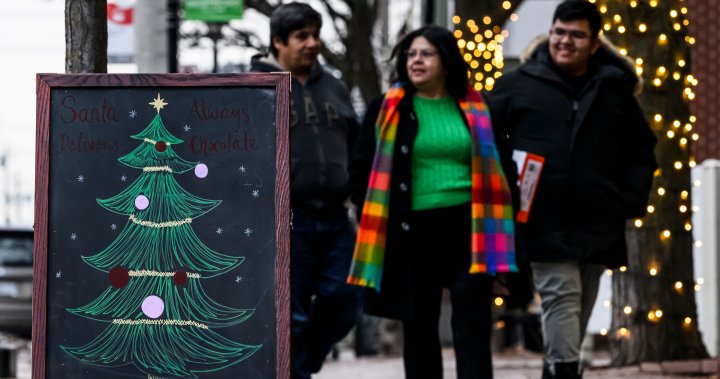Christmas across much of Canada was warmer than normal, with above zero-temperatures from Ontario to the Maritimes while the West Coast braced for heavy rains.
Environment Canada issued fog advisories Monday for much of Ontario, starting from Windsor in the southwest, through Niagara to Belleville in the province’s east.
“Generally not what people want to see around Christmas if they want to see a white Christmas,” said Environment Canada meteorologist Ryan Rozinskis.
The weather agency predicted near-zero visibility on Christmas morning, with fog remaining into the afternoon for some areas, followed by dense fog developing again in the evening.
“But that should be the last of the really foggy nights, at least for now, because we’re going to be getting into some rain tomorrow,” Rozinskis said. “It’s a very light rain or drizzle spreading all over southern Ontario and that’s going to help reduce the amount of fog.”
The agency warned travel could be hazardous due to reduced visibility and said that drivers should slow down, watch for tail lights ahead and be prepared to stop.
Fog is not unusual for this time of year, especially when there are mild conditions.
“The ground can be colder, the lakes are starting to cool down and then we have this surge of warmer, moister air,” said Rozinskis.
“We also have less daylight so less potential of heating, which will also prevent fog. So basically it’s a good pattern when you get warm moist air over southern Ontario in winter to start seeing fog.”
In the nation’s capital, children awoke to a cloudy sky and small clumps of dirt-covered ice on the ground. Ottawa is forecast to reach 4 C Monday afternoon before going down to freezing overnight.
A week ago, Environment Canada said Ottawa had the warmest Dec. 18 since record-keeping started in the city some 134 years ago, reaching 7.1 C on that date.
Get the latest National news.
Sent to your email, every day.
The mild start to the season has locals concerned about the Rideau Canal, which bills itself as the world’s largest outdoor ice rink. Last year, the skateway didn’t open for the first time in 53 years.
Paul Allen wore a light coat that he zipped halfway closed during a midday stroll alongside the canal with his wife Hilary.
“It’s mixed emotions, right? It’s beautiful for walking,” said Paul, an Ottawa native who recalls shovelling six-foot-high snowbanks on Christmas mornings as a child.
The couple is anxious but optimistic the canal will open for skating. They noticed open water last week, but pointed out the thin layer of ice Monday.
Hilary is hoping this will be a better year for cross-country skiing. “For sure, climate change is having an impact; I don’t think you can dispute that,” she said.
The National Capital Commission, the Crown corporation that oversees the skateway, said the Canal can only open if there are at least 10 consecutive days of temperatures between -10 C and -20 C, which typically occurs in mid-January.
Vadim Spac said Monday the muddy ground isn’t very festive for his wife and two kids, but he noticed that their brown poodle was beaming in the mild weather.
“We need to be happy with what we have,” he said with a smile.
In late November, The Weather Network had forecasted a mild Christmas season for Ontario and Quebec, but said much colder temperatures should follow.
Up in northern Ontario, freezing rain is in the forecast for areas such as Timmins and Thunder Bay starting Monday night. It is expected to continue for most of the day on Tuesday, with upwards of 15 millimetres of ice building up on some surfaces.
In Montreal, only small traces of an early December snowstorm remained on the ground as the sun shined on Christmas morning. Environment Canada forecasted positive temperatures throughout the day, peaking at 4 C in the late afternoon and early evening.
The agency’s historical weather data shows Montreal’s average daily maximum December temperature was -1.4 C between 1981 and 2010.
Environment Canada showed the temperature in Fredericton on Christmas Day will reach around 3 C.
The average temperature for this time of the year is a high of -2.6 C and a low of -13.5 C. The low Christmas night is forecast to be 1 C.
Charlottetown is forecast to reach a seemingly balmy 5 C. The average high for this city is -1.5 C and the average low is -10 C at this time of the year.
Prairie cities are experiencing an unusually brown Christmas this year, with many getting just a few centimetres of snow in December.
In Edmonton, less than four centimetres has fallen this month, most of which has already melted, and no snow was recorded at all in the city in November.
Temperatures were below freezing across the West on Christmas Day, but not a flake is forecast for the next week from the Rocky Mountains to Winnipeg.
In B.C., Environment Canada has issued several wind and rainfall warnings, particularly on Vancouver Island.
The agency warns of a “strong weather system” approaching the B.C. coast, forecasting strong winds and heavy rainfall to hit by midday and into Boxing Day.
Warnings issued early Christmas morning say island communities including Tofino, Uclulet and elsewhere could see up to 120 mm of rain, potentially causing “localized flash floods” after heavy downpours.
Environment Canada has also warned of strong winds hitting coastal communities with gusts of up to 120 kilometres an hour, with another storm on approach potentially bringing strong winds into Tuesday and Wednesday.
– With files from Hina Alam in Fredericton, Rob Drinkwater in Edmonton, Darryl Greer in Vancouver, Sammy Hudes in Toronto and Thomas MacDonald in Montreal.


